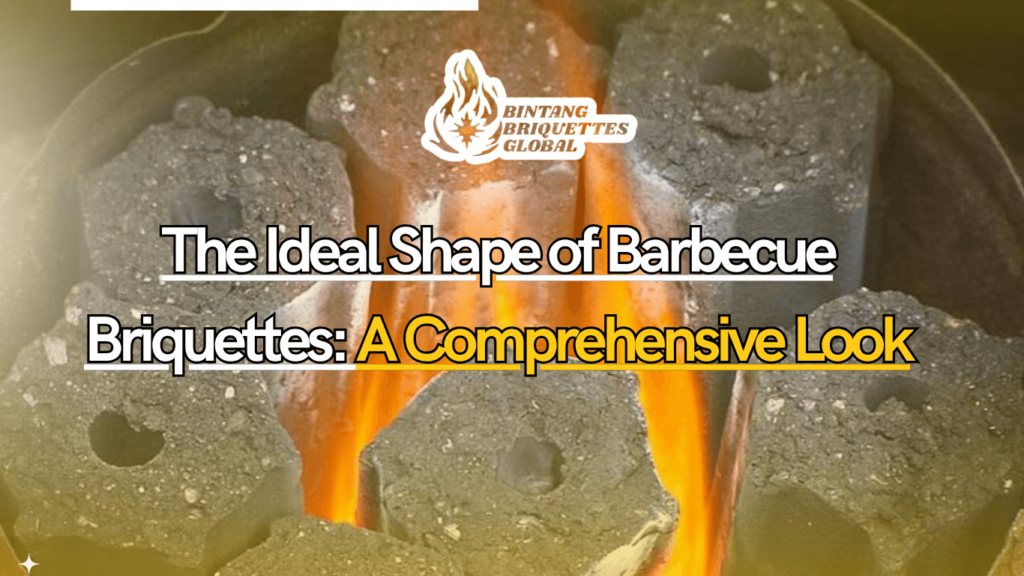bintangbriquettes.com – Grilling enthusiasts know that the fuel used in barbecue plays a crucial role in the final flavor and cooking performance. Among various fuels, barbecue briquettes remain a popular choice for their convenience and consistent heat output. But have you ever wondered how the ideal shape of barbecue briquettes influences your grilling experience?
In this comprehensive look, we will explore why the shape of briquettes matters, the common shapes available in the market, and how each affects heat distribution, burn time, and ease of handling.
Why the Shape of Barbecue Briquettes Matters
The ideal shape of barbecue briquettes is more than just an aesthetic choice. The shape affects how briquettes stack together, their airflow, and ultimately how evenly they burn. Better airflow means hotter and more consistent heat, which translates to perfectly cooked food.
Heat Distribution and Airflow
Briquettes with shapes that allow good airflow prevent oxygen blockage, reducing the risk of uneven burning or flare-ups. For example, traditional pillow-shaped briquettes pack tightly, while hexagonal or cube shapes can create better gaps for airflow.
Burn Time and Fuel Efficiency
The briquette’s shape also impacts how long it burns. Larger or denser shapes typically burn longer, while smaller or irregular shapes may burn out faster. Knowing the ideal shape can help grillers select briquettes that match their cooking style—whether it’s a quick sear or long, slow smoke.
Common Shapes of Barbecue Briquettes and Their Advantages
1. Pillow-Shaped Briquettes
The most common and recognizable shape, pillow-shaped briquettes are oval with rounded edges. They stack closely, providing stable heat but sometimes restricting airflow, which can cause inconsistent burning.
2. Hexagonal Briquettes
Hexagonal briquettes have six sides, creating natural gaps when stacked. This improves airflow, leading to hotter and more even burning. They are also easier to handle and stack efficiently.
3. Cube-Shaped Briquettes
Cube-shaped briquettes offer a balance between density and airflow. Their shape allows for stable stacking and moderate gaps, making them versatile for various grilling needs.
4. Cylindrical Briquettes
These briquettes are shaped like small cylinders and are designed to maximize airflow due to the gaps formed when stacked. They often burn hotter and faster, suitable for quick grilling sessions.
How Shape Influences Heat and Cooking Results
The ideal shape of barbecue briquettes directly impacts heat intensity and uniformity. Shapes promoting good ventilation burn hotter and cleaner, reducing smoke and flare-ups. Conversely, briquettes that pack tightly can smother the fire and create uneven heat zones.
Grill masters often select briquettes with shapes that complement their cooking style—slow smokers prefer longer-burning shapes, while quick grillers may choose those that ignite and burn rapidly.
Material and Manufacturing Influence on Briquette Shape
The shape of barbecue briquettes is also influenced by the materials used and the manufacturing process. Common materials include sawdust, coconut shells, hardwood charcoal dust, and binders that help form the briquettes.
Pressing Techniques and Shape Consistency
High-pressure molding ensures briquettes maintain uniform shape and density, which contributes to predictable burning behavior. Shapes like hexagons or cubes often require more precise molds but result in better stacking and airflow.
Choosing the Right Briquette Shape for Your Grilling Style
For Slow Cooking and Smoking
If you’re a fan of slow-cooked barbecue or smoking, briquettes with larger, denser shapes like cubes or thick hexagons are ideal. They burn longer and maintain steady heat for hours.
For Quick Grilling and Searing
Smaller or more cylindrical briquettes ignite faster and reach high temperatures quickly. These are perfect for quick grilling sessions where you need intense heat.
Storage and Handling Tips Based on Briquette Shape
The shape also affects how briquettes can be stored and handled:
- Stackability: Cube and hexagonal briquettes stack neatly, saving space and allowing air circulation.
- Durability: Rounded pillow shapes can sometimes break or crumble more easily during transport.
- Ease of Use: Smaller shapes ignite faster but require more frequent replenishing.
Environmental and Economic Considerations
Choosing the ideal shape of barbecue briquettes is also linked to sustainability. Some shapes reduce waste during production and improve fuel efficiency, lowering environmental impact and cost.
Manufacturers increasingly focus on eco-friendly shapes and materials that balance performance with sustainability.
Conclusion: Why Shape Matters in Your Barbecue Briquettes Choice
Understanding the ideal shape of barbecue briquettes empowers grillers to optimize their grilling experience. The right shape can mean better heat management, longer burn times, and tastier food.
Next time you shop for briquettes, consider not just the material but also the shape—because every detail counts toward the perfect barbecue.

